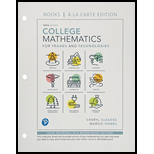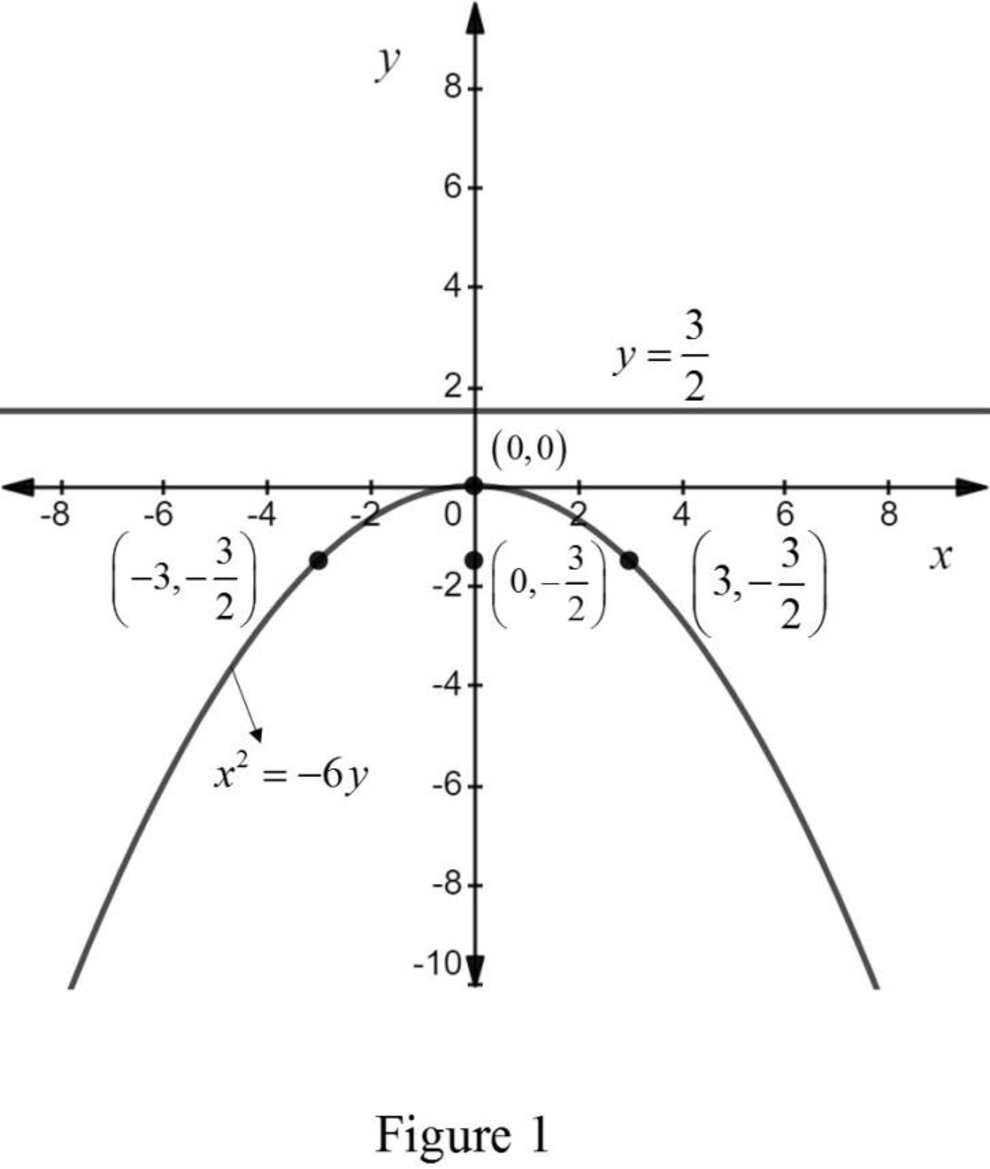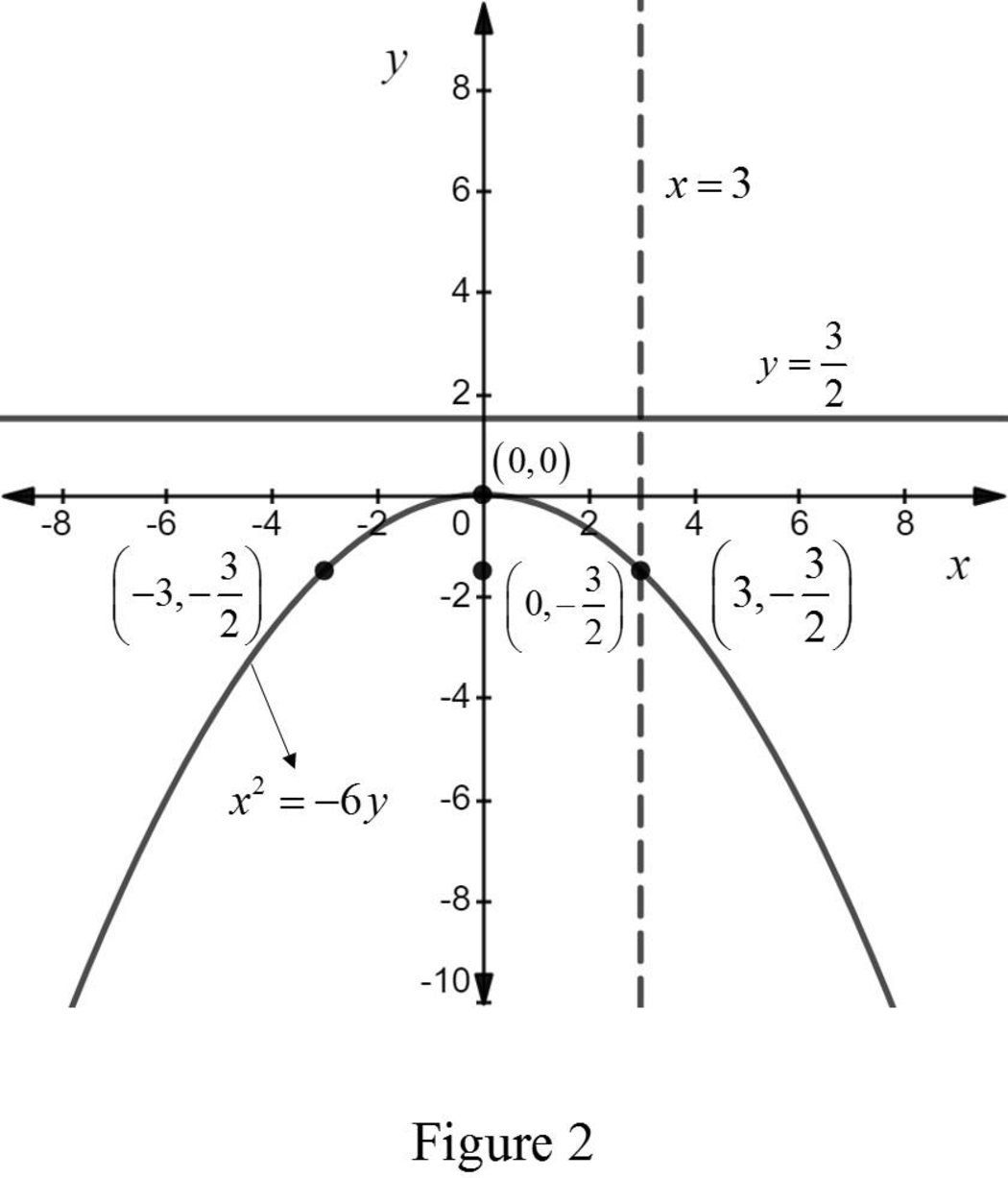
Concept explainers
The coordinates of the vertex, focus and the equation of directrix.
Answer to Problem 1RE
The coordinates of the vertex is
Explanation of Solution
The given equation is
It is of the standard form
The coordinates of the focus is
Find the value of
Therefore, the coordinates of the focus is
Standard equation of directrix is
Hence, for the given equation
Therefore the coordinate of the vertex is
To sketch: The parabola and its directrix for the equation
Explanation of Solution
Procedure used:
To sketch a parabola for an equation in the form
1. Write the given equation in the standard form
2. Calculate the value of
3. Plot the vertex at
4. The directrix
5. Substitute the
6. With vertex at
Calculation:
The given equation is
From the above part
Therefore, the coordinate of focus and equation of directrix are
Substitute the value of
Taking square root on both sides.
Therefore, the points are
The parabola and its directrix is sketched as follows:

From the above graph it is observed that
Whether the given equation is a function or not.
Answer to Problem 1RE
The given equation
Explanation of Solution
Procedure used:
To check whether the given equation is a function or not:
1. Plot the graph for the given equation.
2. For the resulting graph, apply the vertical line test.
3. Check whether the vertical line touches the parabola at only one point.
4. If the above condition is true, then the given equation is a function otherwise it is not a function.
Calculation:
The graph for the given equation is drawn as given below.

From the above figure it is observed that in the vertical line test the vertical line
Therefore, the equation
Want to see more full solutions like this?
Chapter D Solutions
College Mathematics for Trades and Technologies, books a la carte edition (10th Edition)
- One hundred people were surveyed, and one question pertained to their educational background. The results of this question and their genders are given in the following table. Female (F) Male (F′) Total College degree (D) 30 20 50 No college degree (D′) 30 20 50 Total 60 40 100 If a person is selected at random from those surveyed, find the probability of each of the following events.1. The person is female or has a college degree. Answer: equation editor Equation Editor 2. The person is male or does not have a college degree. Answer: equation editor Equation Editor 3. The person is female or does not have a college degree.arrow_forwardPlease draw a detailed grapharrow_forwardFor allarrow_forward
- not use ai pleasearrow_forward3) Let G be the group generated by elements a and b satisfying the relations a² = 63, 66 = 1, and a ¹ba = b¹. Which of the following is equivalent to the element z = a a-2ba3b3? A) b-2a-1 B) ab² C) ab D) ba E) b²aarrow_forward1) Find all complex solutions to cos(z) =arrow_forward
- 3) Compute where C is the circle |z― i| = - 1 2 2+1 Po z z - 2)2 dz traversed counterclockwise. Solution: TYPE YOUR SOLUTION HERE! INCLUDE A SKETCH OF THE COM- PLEX PLANE AND THE CURVE C. ALSO, MARK ALL SINGULARITIES OF THE INTEGRAND!arrow_forward2) Consider the function f (z = re²) = e cos(In(r)) + ie¯* sin(ln(r)). Show that is holomorphic at all points except the origin. Also show that =arrow_forward3) If a is a positive number, what is the value of the following double integral? 2a Love Lv 2ay-y² .x2 + y2 dadyarrow_forward
- 2) Consider the set SL(n, R) consisting of n x n matrices with real entries having de- terminant equal to 1. Prove that SL(n, R) is a group under the operation of matrix multiplication (it is referred to as the Special Linear Group).arrow_forward1) What is the parity of the following permutation? (1389) (24) (567)arrow_forward4.7 Use forward and backward difference approximations of O(h) and a centered difference approximation of O(h²) to estimate the first derivative of the function examined in Prob. 4.5. Evaluate the derivative at x = 2 using a step size of h = 0.2. Compare your results with the true value of the derivative. Interpret your results on the basis of the remainder term of the Taylor series expansion.arrow_forward
 Discrete Mathematics and Its Applications ( 8th I...MathISBN:9781259676512Author:Kenneth H RosenPublisher:McGraw-Hill Education
Discrete Mathematics and Its Applications ( 8th I...MathISBN:9781259676512Author:Kenneth H RosenPublisher:McGraw-Hill Education Mathematics for Elementary Teachers with Activiti...MathISBN:9780134392790Author:Beckmann, SybillaPublisher:PEARSON
Mathematics for Elementary Teachers with Activiti...MathISBN:9780134392790Author:Beckmann, SybillaPublisher:PEARSON
 Thinking Mathematically (7th Edition)MathISBN:9780134683713Author:Robert F. BlitzerPublisher:PEARSON
Thinking Mathematically (7th Edition)MathISBN:9780134683713Author:Robert F. BlitzerPublisher:PEARSON Discrete Mathematics With ApplicationsMathISBN:9781337694193Author:EPP, Susanna S.Publisher:Cengage Learning,
Discrete Mathematics With ApplicationsMathISBN:9781337694193Author:EPP, Susanna S.Publisher:Cengage Learning, Pathways To Math Literacy (looseleaf)MathISBN:9781259985607Author:David Sobecki Professor, Brian A. MercerPublisher:McGraw-Hill Education
Pathways To Math Literacy (looseleaf)MathISBN:9781259985607Author:David Sobecki Professor, Brian A. MercerPublisher:McGraw-Hill Education





